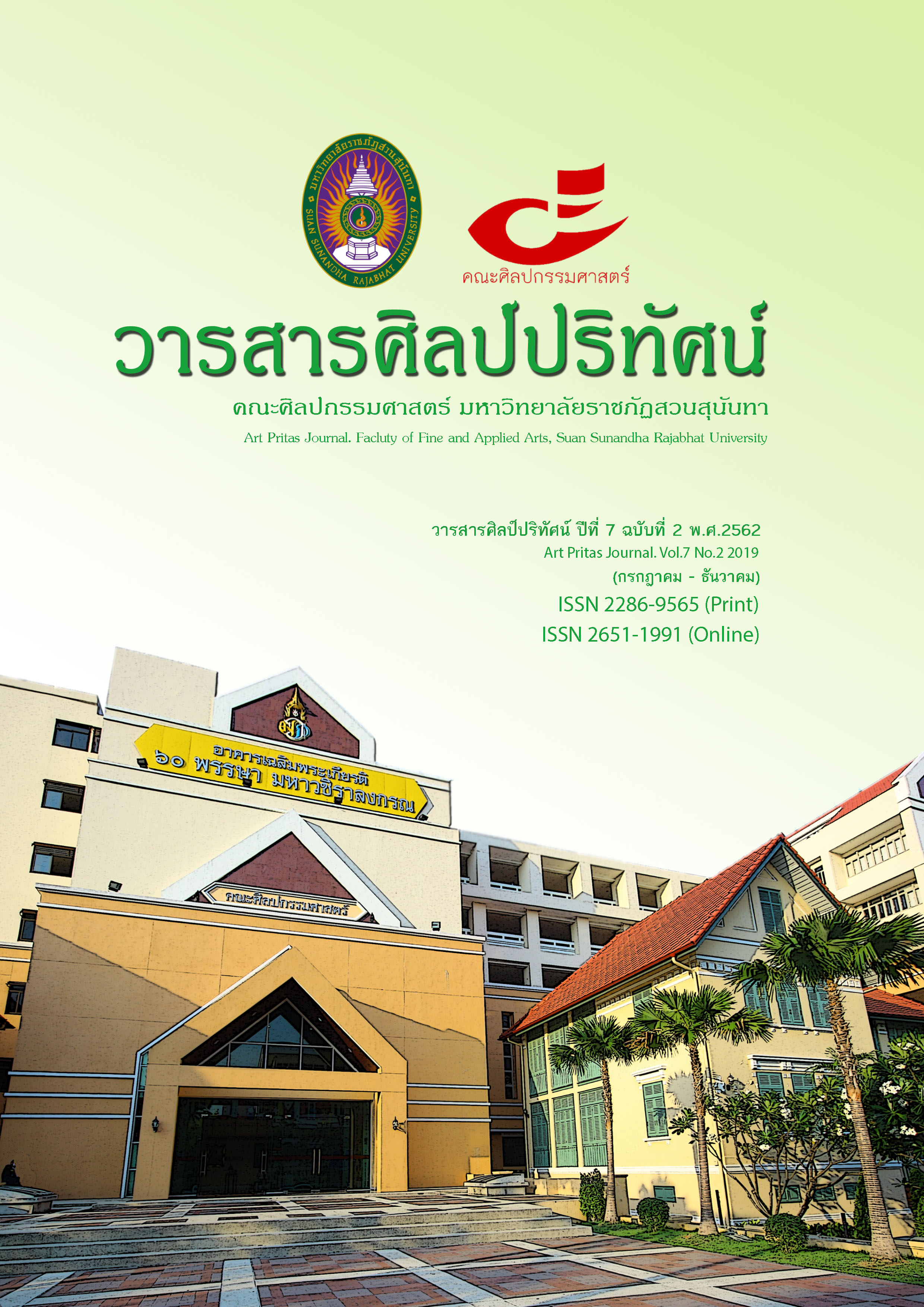การพัฒนาทักษะการแสดงเพื่อสร้างตัวละครผู้หญิงจีน ในการแสดงเรื่อง รายละเอียด ไม่ได้ ร่างกาย อยาก ของ ชิน วุน ปิง ตามหลักการแสดงของไมเคิล เชคอฟ
Main Article Content
บทคัดย่อ
วัฒนธรรมส่งผลต่อการแสดงออกทางความคิดและพฤติกรรมของผู้คนในสังคม หล่อหลอมอัตลักษณ์ของแต่ละเชื้อชาติ
ให้มีความโดดเด่นและมีลักษณะเฉพาะ ผู้วิจัยจึงตั้งข้อสังเกตว่าบริบททางสังคมและวัฒนธรรมที่แตกต่างกันนี้อาจเป็นอุปสรรคสำหรับนักแสดงในการเข้าถึงบทบาทของตัวละครที่มีลักษณะวัฒนธรรมและชาติกำเนิดที่แตกต่าง ทำให้ผู้วิจัยเกิดความสนใจที่จะศึกษาวิธีการเข้าถึงบทบาทของตัวละครที่อยู่ในวัฒนธรรมอื่น
วัฒนธรรมจีนเป็นวัฒนธรรมที่มีอิทธิพลวัฒนธรรมหนึ่งในสังคมเอเชีย เป็นวัฒนธรรมที่มีอิทธิพลต่อการแสดงออก
ทางความคิดและพฤติกรรมของคนในสังคมโดยเฉพาะผู้หญิงเป็นอย่างมาก ผู้วิจัยจึงตัดสินใจเลือกวัฒนธรรมจีนมาเป็นกรณีศึกษาผ่านการแสดงเรื่อง รายละเอียด ไม่ได้ ร่างกาย อยาก ที่สะท้อนปัญหาเรื่องทัศนคติและค่านิยมของสังคมที่มีต่อผู้หญิงเชื้อสายจีน ส่งผลกระทบต่อการดำเนินชีวิตของผู้หญิงเชื้อสายจีนในสังคมเอเชียมาจนถึงปัจจุบัน โดยเน้นค้นหาวิธีการเข้าถึงตัวละครที่แม้มีลักษณะทางกายภาพและสภาพสังคมคล้ายคลึงกันแต่มีความรู้สึกและการแสดงออกต่อการถูกกดทับจากวัฒนธรรมในสังคม
ในระดับความเข้มข้นที่แตกต่างกัน
ผู้วิจัยเลือกหลักการแสดงของไมเคิล เชคอฟ ที่มุ่งเน้นการใช้จินตนาการเพื่อสร้างตัวละครที่มีเอกลักษณ์เฉพาะ โดยผสานการทำงานของจิตใจและร่างกายเพื่อเป็นตัวละครที่แท้จริงจากภายใน มาใช้เป็นแนวทางในการค้นหาวิธีการเข้าถึงตัวละคร โดย
เชื่อว่าหลักการแสดงของไมเคิล เชคอฟนี้จะสามารถช่วยผู้วิจัยในฐานะนักแสดงให้สามารถเข้าถึงบทบาทของตัวละครผู้หญิงจีน
ที่วัฒนธรรมส่งผลต่อการแสดงออกทางความคิดและพฤติกรรมที่ซับซ้อนได้
Article Details
เนื้อหาและข้อมูลในบทความที่ลงตีพิมพ์ในวารสารศิลป์ปริทัศน์ ถือเป็นข้อคิดเห็นและความรับผิดชอบของผู้เขียนบทความโดยตรง ซึ่งกองบรรณาธิการวารสารไม่จำเป็นต้องเห็นด้วย หรือร่วมรับผิดชอบใดๆ
บทความ ข้อมูล เนื้อหา รูปภาพ ฯลฯ ที่ได้รับการตีพิมพ์ในวารสารศิลป์ปริทัศน์ถือเป็นลิขสิทธิ์ของวารสารศิลป์ปริทัศน์
เอกสารอ้างอิง
Ahmad, N. (2005) The first R-rated play. Retrieved June 18, 2018. From
http://eresources.nlb.gov.sg/infopedia/articles/SIP_53_2005-02-02.html
Arnott, P. D. (1959). An introduction to the Greek theatre. London: Macmillan Press Ltd.
Ashperger, C. (2007). Michael Chekhov’s Acting Technique in Contemporary Pedagogy and Practice (Doctoral dissertation). Canada: University of Toronto.
Beauvoir, S.D. (1956) The Second Sex. 2 ed. (pp.273-277). London: Lowe and Brydone (Printers) Ltd.
Chekhov, M, and Gordon, M. (1991) On the Technique of Acting. New York: HarperCollins.
Petit, L. (2010) The Michael Chekhov Handbook: for the Actor. New York: Routledge.
Simão, L. (2015) “Culture as a Moving Symbolic Border.” Integrative Psychological and Behavioral Science, vol. 50, no. 1, pp. 5. doi:10.1007/s12124-015-9322-6.
Suzuki, T. (2003) The Way of Acting. USA: Theatre Communications Group.
Thulaja, N.R. (2004) Film classification guidelines – Restricted (Artistic) category. Retrieved May 16, 2019. From
http://eresources.nlb.gov.sg/infopedia/articles/SIP_15_2004-12-27.html
Woon Ping, C. (1993) The Naturalization of Camellia Song. (pp.118). Singapore: Times Book International.
ภาษาไทย
นพมาส แววหงส์ (2558). “องค์ประกอบของบทละคร.” ใน ปริทัศน์ศิลปการละคร, (น.3). กรุงเทพมหานคร: โครงการเผยแพร่
ผลงานวิชาการ คณะอักษรศาสตร์ จุฬาลงกรณ์มหาวิทยาลัย.
สุชาดา ทวีสิทธิ์. (2550) “ผู้หญิง ผู้ชาย เพศวิถี: เพศภาวะศึกษาในงานมานุษยวิทยา.” วารสารสังคมศาสตร์ คณะสังคมศาสตร์
มหาวิทยาลัยเชียงใหม่, ปีที่ 19, ฉบับที่ 1, (น.5). เชียงใหม่.


